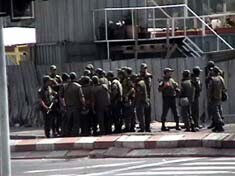Today (October 15) I planned to go photograph a new discovery of the visual art of Al Quds (Jerusalem). The Coptic Church in the old city is filled with two rows of murals on all of its walls, executed in 1961 by a Palestinian artist who had experienced the Nakbe. A friend stopped me, saying go run now or else I’d would be stuck in the crush of people going to pray the noon prayer at Al Aqsa. Not only is it Friday, but it’s also the first day of Ramadan. And oh, she added, the place will also be full of Israeli soldiers and police — they will seem to number as many as the worshipers, she said.
I abandoned my initial plan for the opportunity presenting itself. The murals will wait for me. I marched down toward Bab Al Amoud (Damascus Gate) and noticed that already at 10 a.m. there were groups of people marching in one direction towards the Gate and thence to the Aqsa. Israeli soldiers and police were scattered everywhere, in groups for protection. They were at every corner and ten other locations between corner and corner. Their numbers grew as I approached the Gate. They were inside the streets of the old city and in all its alleys, and at other gates. There were truck loads of soldiers two to three blocks away. All were armed and wearing bullet proof vests and they had helmets — both police and soldiers. These armed Israelis were harassing youth, especially the men. I saw them searching bags and demanding identity cards. Their performance was extreme. There were also mounted police. There was a while balloon above, like the old Goodyear ones, and there were helicopters.
It seems that the pious Muslims going to pray during an important religious day present a particular kind of emergency to the Zionist’s mind. This is definitely harassment at the very least.

A group of soldiers, one of many on the streets on the first day of Ramadan (Photo: Samia A. Halaby)

Orthodox Jews, coming from the Wailing Wall, pass through the Muslim quarter of Jerusalem’s Old City (Photo: Samia Al Halaby)
I, along with all the Palestinians that I saw, walked between these Israeli examples of international fascism like sand through a sieve. Most of us do not pay them direct attention and pass as though they are not there. This was not easy to do as often you saw them in a row like a wall facing you, blocking your way, with only one to two feet of space between them, their gun barrels sweeping your clothing. Yet we walked through them and occasionally looked back. I selected the narrowest paths between any two soldiers to pass through challenging their intentions. They would move aside just enough to let me through. This would not be possible for someone who did not look and walk like a foreigner — middle class and possibly even Israeli. A very old man, walking slowly uphill in the hot sun, looked up at one of the soldiers in such formation and gave him a half smile — the smile of the helpless, like that of children.
The evening of that day, I went again to Bab Al Amoud so that my Japanese friends would see something of the old city. As we approached the gate, a veritable river of Orthodox Jews in black robes and many differently shaped hats of fur, followed by conservatively dressed women, was streaming out of Bab Al Amoud. Many looked frightened and were rushing, even though the way was full of Israeli police to protect them and to harass the Palestinians. The further inwards we walked, towards the Austrian Hostel, the more we saw of them and the faster they moved.
I asked several shop-keepers where all the conservative Jews were coming from, and they said from the Wailing Wall. It seems that to take the short way home from the Wailing Wall had been rejected in favor of the long way — a deliberate provocation. The long way demanded much frightened walking through the Muslim Quarter and an exit through Bab Al Amoud. In the West Bank and Ghazze (Gaza) we witness occupation through civilian residence, here we witness occupation through roundabout religious practice.
I showed my friends the house that Israeli Prime Minister Ariel Sharon confiscated in the middle of the Arab neighborhood of the old city. He does not live in it, yet it sits there with an Israeli flag hanging from its roof streaming down the entire face of the house — another clear symbol of Zionist ill intent. An embarrassment to Israel that is exceptionally good to show visitors. My Japanese friends were aghast at all they saw looking up trying to process the implications of this obscene act of occupation.
As we turned to depart the old city, I noticed that masses of Palestinians were now streaming inward in the opposite direction of the Orthodox Jews who were now growing fewer and rushing more hectically. It was a stream of Palestinian Muslims returning to the Aqsa for evening prayer, returning as we who are in exile yearn to return to Palestine
Samia A. Halaby (1936) was born in Jerusalem. In 1948 she was forced to leave Palestine. Via Beirut, her family emigrated to the United States. She has worked at American universities for years, ending at the Yale School of Art. Her art has been exhibited internationally, including the Guggenheim Museum, the Art Institute of Chicago and the Institute Du Monde Arab.





